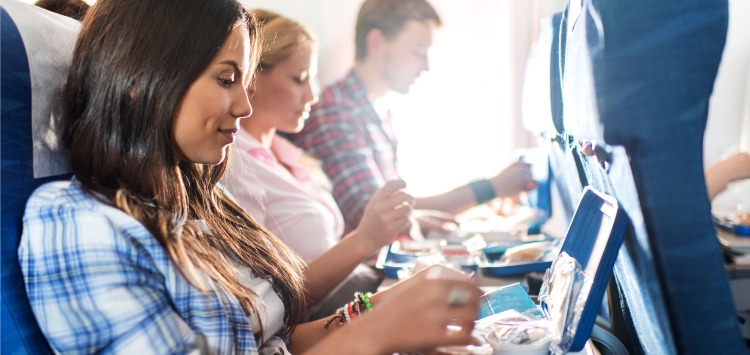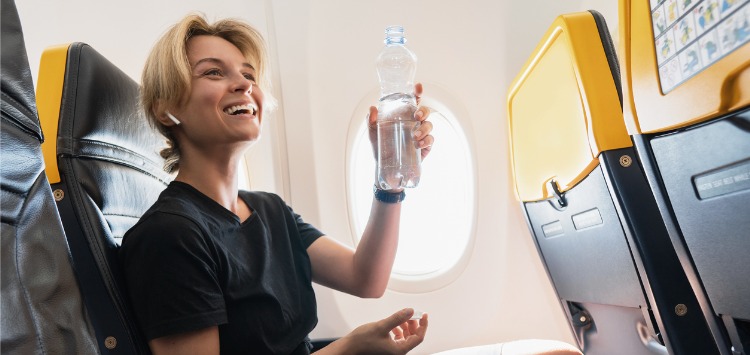
Have you ever landed at your destination after a long flight feeling your stomach is bloated, your skin dried out, and completely exhausted? By spending a little time before your flight to get organised, you can combat the effects of flying and land feeling great.
Air travel isn’t too kind to the human body. The low humidity in the cabin, at around 20%, can cause dry skin and eye irritation for some people. Cabin pressure causes the gas in our body cavities to expand, so you feel bloated. However, prioritising your nutrition and skincare can help you get to your destination feeling rejuvenated. It’s as simple as making some changes to your diet and taking a few extra items in your hand luggage.
Nutrition Travel Tips
Airline food has greatly improved in the last decade or so. Much research and development have gone into which foods perform best at being reheated and which taste best at 30,000 feet above the earth. Nevertheless, there’s still plenty of research missing; the lack of moisture in cabin air means our sense of smell is affected, so foods taste different. Our perception of saltiness and sweetness is reduced by around 30%, but increasing the amount of salt and sugar in foods too much makes passengers suffer from bloating and dehydration.
There are things you can do to improve your nutritional intake on flights, such as:
#1 Take Your Own Healthy Meals and Snacks
This is a reality for many travellers because budget airlines don’t offer meals as part of the ticket cost. Snacks and light meals are available on board at an additional cost, but few of these are healthy options, so it makes sense to give them a miss and bring your own.
Make or buy a wrap, sandwich, or roll with plenty of vegetables and protein to keep you satisfied. Stay away from juicy fillings like a sliced tomato that can make the bread wet, or choose thick bread like ciabatta or focaccia. For snacks, take nuts and a handful of dried or fresh fruit if there are no border restrictions. Protein bars are also easy to pack, but make sure you get ones with high-quality ingredients and little or no added sugar.
#2 Eating Airline Food on a Long Flight
If you’re on a long-haul flight, meals will usually be included in your plane ticket. When it's meal time, choose the healthier option and stop eating when starting to feel full, don’t fall into the trap of overeating on the flight. The main meals may be closer together, so if you aren’t that hungry, eat the healthy snacks you brought on the flight rather than another hot meal. Your body will thank you.
#3 Do your Research About the Airline Food
Before you’re due to fly, look up the menu if possible, especially if it is your first time flying with this airline. Most airlines serve their national dishes. For example, on Japan Airlines you may have a meal similar to what you’d expect in a bento box, and on Thai Airways you may get a curry or a Pad Kee Mao. If the menu doesn’t sound like it suits your taste buds or you know it’s something your body will react to, you have time to prepare your own or request a dietary requirement meal that may be more to your body’s liking.
Best Hydration Travel Tips
It’s a well-known fact that flying causes dehydration. The human body loses about 0.25 litres of water per hour when jumping on a plane, just by breathing. The Aerospace Medical Association recommends drinking at least 0.25 litres of water per hour to replenish these lost liquids.
The best thing you can do to combat dehydration on a flight is to up your water intake and reject all offers of other drinks. Soft drinks contain sugar, and tea and coffee contain caffeine. Both sugar and caffeine are diuretics, so the water content of the drink is compromised. Alcohol dehydrates the body and brain, so as tempting as a beer or wine may be to pass the time, stick to water.
Even without an alcoholic drink on board, you can leave the plane feeling hungover and suffering from a headache because the body is dehydrated. Continue reading to find out how to arrive at your destination feeling refreshed and healthy rather than suffering from jet lag and a headache.
#1 Start Hydrating Well Before the Flight
If you aren’t keen on drinking litres of water during the flight because you don’t like getting up and using the airline toilet regularly, start hydrating well before the flight. If you've had plenty to drink during the 24 hours before the flight and cut back on any diuretic drinks, your body will be in the best shape possible to cope with the dehydrating cabin air.
#2 Take Your Own Drinks
Don’t rely on the water being offered to you. Bring your empty water bottle if rules and regulations allow, and ask for your bottle to be filled early in the flight. You may consider taking an unopened electrolyte drink to help replenish minerals such as potassium, calcium, and magnesium that tend to lower from the increased air pressure during the flight. Alternatively, you can make up your own by taking the powder on board and adding it to water - just make sure these products aren't loaded with unnecessary added sugars.
#3 Take Hydrating Foods on Board
Taking hydrating foods on board means you don’t need to rely on guzzling water alone to stay hydrated. Chia seeds can absorb thirty times their weight in water, so prepare some muffins with a tablespoon of chia seeds added to the mix or a chia pudding.
If you find the airline food salty and dehydrating, take a meal or snacks you can eat instead of the ones offered. A salad has plenty of water content, so you don’t need to rely on drinking water to stay hydrated. Cucumbers, lettuce, and tomatoes are also mostly water. If you take a fruit salad on board, make it watermelon, peaches, and apples, which have high water content. For snacks, skip the salted varieties and take your unsalted nuts.
However, please check prior to boarding the flight if these foods are able to be brought on board, depending on where you are travelling to.

Tips for Skincare Onboard
Flight cabins are much less humid than our homes. At home, the humidity ranges between 30-65%, while in a plane’s cabin, it can be as low as 10-20%, similar to that of a desert. But you can take a few simple steps to combat the drying effects of flying on your skin.
#1 Hydration for the Skin Before You Fly
During winter, your skin may already be suffering from dryness. Start implementing extra hydration to your skin one week before your flight to reduce the effects of winter and flying.
Use a hydrating toner and moisturiser and apply with the layering effect. If you usually tone and moisturise once, you can repeat the toning and moisturising process two or three times more so your skin soaks up extra water. Before leaving the house, apply sunscreen as the last step to lock in the moisture.
#2 Skincare During the Flight
Believe it or not, sunscreen is particularly important on a flight as there is no protection from damaging UV rays from the untinted windows.
It is most likely you won’t be able to complete your night skincare routine on the plane, but get to the basics. Bear in mind you may need to spend some time moving your skincare products out of their original packaging to meet airline requirements for carry-on luggage. Any liquids, aerosols, or gel items you want to take into the cabin must be in containers that are a maximum of 100 millilitres or 100 grams. These containers must also fit into one transparent and re-sealable plastic bag like a snap-lock bag. The four sides of the bag's sealed area must add up to no more than 80 cm.
One product you should consider taking with you is a face oil to apply every hour or two to retain the water in your skin. Applying an oil-based product as the last step of your routine will provide a protective barrier and prevent the moisture deep within the skin from evaporating.
#3 Skincare After the Flight
After landing, your skin will need some extra TLC. Use a gentle face scrub or exfoliator to remove dry-surface skin. This will also boost circulation to the outer layers of the skin and brighten a tired-looking complexion. If you’re struggling with jet lag, at least your skin will feel awake! Next, use a hydrating face mask to add moisture and brighten dull skin. Continue to lather your skin with moisturiser and sunscreen.
Use products on your skin that you've tried and tested before travelling. Don’t be tempted to take the free sample skincare products you have received because they’re small and easy to pack. Use the products for at least a week before you travel to make sure you don’t have any skin reactions when arriving on holiday.
#4 Eye Care While Flying
If you suffer from dry eye or wear contact lenses, you are at increased risk of the cabin's low humidity and air pressure. Consider using eye drops to keep your eyes well-lubricated. Pack your contact lenses and wear glasses on the flight instead. Your dry eyes will feel less irritated than if you have contact lenses. Just like your skin, your eyes rely on you to stay hydrated. Maintain your water intake and skip the alcohol and caffeine during the flight to look after your eyes.
Whether you're looking to explore Western Australia, Australia, or fly overseas, check out our different travel insurance plans to cover personal liability, luggage, unexpected trip cancellation*, and more*. Travelling stress-free can upgrade your trip to another level.